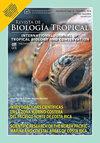Testing the effectiveness of natural and artificial substrates for coral reef restoration at Isla Isabel National Park, Mexico
IF 0.6
4区 生物学
Q4 BIOLOGY
引用次数: 0
Abstract
Introduction: The branching coral Pocillopora is the main reef-building species in the Eastern Tropical Pacific (ETP) region. However, their populations have been threatened due to the intense effect of thermal-stress events in the last three decades. As a mitigating response, active restoration strategies have been developed. However, it has not been possible to establish specific protocols along the ETP’s reefs. Objective: To evaluate the efficiency of two different substrates (natural vs. artificial), through coral growth comparison (extension rate and tissue area) in three Pocillopora coral morphospecies within a year. Methods: Coral growth was estimated by two techniques: extension rate and tissue area of P. cf. verrucosa, P. cf. capitata, and P. cf. damicornis every three months during a year. Results: The extension rate and superficial area growth vary among the coral morphospecies P. cf. verrucosa (16.33 mm yr-1 and 168.49 mm2 yr-1), P. cf. capitata (16.25 mm yr-1 and 176.83 mm2 yr-1), and P. cf. damicornis (12.38 mm yr-1 and 87.62 mm2 yr-1). The data reveals that substrate type did not affect Pocillopora growth, yet there was an effect caused by seasonal changes. Conclusions: This study demonstrates that coral restoration can be implemented using both natural and artificial substrata, with no differences in coral growth. We recommend the implementation of coral reef restoration programs, highlighting the importance of initiate during the warm season due to optimal growth performance of P. cf. verrucosa and P. cf capitata species, which improves the effectiveness of management actions in Isla Isabel National Park.在墨西哥伊莎贝尔岛国家公园测试自然和人工基质对珊瑚礁恢复的有效性
简介:分支珊瑚Pocillopora是东热带太平洋(ETP)地区的主要造礁物种。然而,在过去三十年中,由于热应力事件的强烈影响,它们的种群受到了威胁。作为缓解措施,已经制定了积极的恢复战略。然而,还不可能在ETP的珊瑚礁上制定具体的协议。目的:通过比较三种Pocillopora珊瑚形态物种在一年内的珊瑚生长(延伸率和组织面积),评估两种不同基质(天然基质和人工基质)的效率。方法:通过两种技术估算珊瑚生长:疣状珊瑚、头状珊瑚和达米科尼珊瑚在一年中每三个月的扩展率和组织面积。结果:疣状珊瑚(16.33 mm yr-1和168.49 mm2 yr-1)、头状珊瑚(16.25 mm yr-1,176.83 mm2 yr-1。数据显示,基质类型不影响Pocillopora的生长,但存在季节变化引起的影响。结论:本研究表明,珊瑚修复既可以使用天然基质,也可以使用人工基质,珊瑚生长没有差异。我们建议实施珊瑚礁恢复计划,强调在温暖季节启动的重要性,因为疣状P.cf.和头状P.cf..物种的生长表现最佳,这提高了伊莎贝尔岛国家公园管理行动的有效性。
本文章由计算机程序翻译,如有差异,请以英文原文为准。
求助全文
约1分钟内获得全文
求助全文
来源期刊

Revista De Biologia Tropical
生物-生物学
CiteScore
1.80
自引率
0.00%
发文量
23
审稿时长
4-8 weeks
期刊介绍:
The Revista de Biología Tropical / International Journal of Tropical Biology and Conservation is a mainstream scientific journal published since 1953 and covered by Web of Science; Science Citation Index; Current Contents; Google Scholar; Scopus, SciELO and nearly 50 additional indices.
A double blind system guarantees you a fair evaluation, and our world class editorial and scientific boards provides a first decision in three working days. The journal is Full Open Access and is widely read where your article can have the highest real impact.
Since its beginning in 1953, the Revista follows these principles: objective and independent evaluation of all manuscripts; transparency in all processes; ethical use of procedures, data, specimens and subjects; fair treatment of all parties; and absolute predominance of scientific rigor over any other aspect.
 求助内容:
求助内容: 应助结果提醒方式:
应助结果提醒方式:


